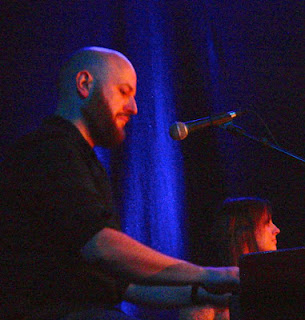Scotland's music: The Woods from Hamish Napier
When you walk in a wood, what do you see? Weathered bark and new green sprouts, tall trunks and saplings, mosses, lichens, green leaves, red ones, brown ones, ones which have turned to gold, flowers, evergreen branches, yellow gorse, purple heather...
What do you hear? Bird song, the rustle of a deer as it moves through the wood, the dart of a squirrel, the voices of the waters, your own footsteps over rock and soil and leaf.
Perhaps you sense a whisper of stories of those who have walked this way before you, as well.
Hamish Napier has heard all these things, and more.
The woods he has in mind, and in experience, are those in the Cairngorms in Scotland’s Highlands.
The ideas, and the place, became resources he’d draw on the create the music for his album The Woods. Napier was commissioned to create The Woods by Cairngorms Connect, which is a joint project of RSPB Scotland, Wildland Limited, Scottish Natural Heritage, and Forestry & Land Scotland.
Through the album, Napier and his musical friends offer a journey that draws on music of Scotland’s traditions and ideas from nature, history, and language to create new stories and honour older ones.
Just as you experience light and shadow, close up views and wide ones, intricate tracery of fern and flower and boldness of high soaring tree trunks when you are in a forest, so to Napier and his musical friends reveal and share aspects of many aspects of woodlands on their journey
It used to be that children in Scotland were taught the Gaelic alphabet through learning names of trees. That comes into play as Napier chooses names for many of his tunes and draws inspiration for their creation, from different sorts of trees and the roles they play in the forest. Other aspects of woodland landscape, creatures and stories appear from time ot time as well.
Of the opening track, The Pioneer, which is tied to beith, the letter b, Napier writes “A Slow air for the beautiful birch. B is the first letter of the Early Medieval alphabet (the Ogham) which is very apt as it was one of the pioneering species to spread across the barren post ice age landscape 10 millennia ago...”
He goes on to talk of birch across the seasons, and of the uses to which it was put by Highlanders of old. You do not, of course need to know any of this to appreciate the beauty of the tune. It does give context to inspiration, creation, and connection, however. On The Pioneer, Napier plays bamboo flute and piano. He is joined by Steve Byrnes on guitar and drums, Innes Watson on fiddle and strings, Jarlath Henderson on uilleann pipes, James Lindsay on double bass, Su-a Lee on cello, and there are vocals, so to speak, from natural sounds of woodpecker, chaffinches, and swifts.The Woods is an album that invites and rewards listening all the way through as the musicians have presented it. Much like a wander in physical woods, though, you can follow markd paths or go along other ways.
That said, several tracks I’d point out to you:
The Capercaille Rant/An Taghan is a fast paced celebration and evocation of the at times dramatic and in Napier’s words, otherworldly bird of the woods. “The giant grouse fly through the Scots pinewood with all the grace of a cannonball,” Napier writes. In nature the capercaillie’s rival is the pine martin, an taghan, “one of Scotland’s most beautiful and beloved predators.”
On The Tree of Blessings, you will hear Napier’s solo piano as he plays in tribute to the juniper. The Tree of Life/The Tree of Lightning is a a majestic and complex tune for the dair, the darach, the mighty oak. Though these days oak are more abundant in the west of Scotland than in the Cairngorms, there is archeological evidence that they were important centuries ago. Individual oak tress may in fact live for centuries. Druids and others considered the oak to be a doorway between worlds, too. More than enough from which to be drawing ideas for a tune...
Forest Folk is a tune at once lively and gentle, with a melody you’ll quickly catch on to. It is inspired by the flowers of the forest, and dedicated to those who go for a wander in the woods. “Find a big tree, lie at the foot of the trunk, and gaze up at the clouds drifting high above the branches,” Napier writes in the sleeve notes booklet, which you may gather from these excerpts I’ve ben sharing it is quite extensive and well worth repeated reading. The booklet also includes outstanding art work by Somhairle MacDonald. Take some time with his drawings, and with what Hamish Napier has written as well. Both will add to your understanding and appreciation of the music.
Hawthorne River/The Witches’ Tree begins with the voice of the River Spey and moves into tunes which, though newly composed, readily evoke Highland music of older times, as well as the presence of the river, the hawthorn, and the blackthorn.
The Tree of the Underworld speaks of the elm tree and draws on a story from 19th century forestry, I’ll leave you to seek that out through the sleeve notes. Suffice it to say that in addition to fine work on the cello, Su-a Lee plays her musical saw to haunting effect.
The March of the Lumberjills, and the letter R, ros for wild roses, give the nod to the Women’s Timber Corps, who came to work in forests during World War II. One of these women was Hamish Napier’s grandmother, who subsequently married and settled in the Highlands. The Regeneration March holds a bit more stately aspect, as befits a tune drawn from the idea of heather and forest reclaiming land which had been changed by both felling and wild fire. Calum MacCrimmon (you will know him from his work with the band Breabach) lends Gaelic singing to The Highest Willows which, though in the style of a lament, is a hopeful piece drawing many threads of the stories told in The Woods together.
There is quite a bit more to unpack and enjoy in The Woods, both in the music and the sleeve notes booklet. Both are well worth repeated exploration.
Here you may find out more about The Woods as well other projects from Hamish Napier.
You may also wish to see
Hamish Napier: The River
Hamish Napier’s album The Railway.
Eddi Reader: Cavalier
The Ledger, an album from Hamish Napier’s brother Findlay Napier and sister-in law Gillian Frame, with their friend Mike Vass
--> Your support for the work at Music Road is welcome and needed. If you are able to chip in, consider
Two ways to offer support:
One through PayPal. You do not have to have a PayPal account to do this.
Sign not up required to chip in here either
If you enjoy what you are reading here, come visit -- and perhaps, subscribe -- to my newsletter at Substack for more stories about music, the people who make it, and the places which inspire it.
Labels: cairngorms. Scottish Highlands, composer, creativity, forest, gaelic, gaidhlig, hamish napier, history, music of scotland, nature, scotland, woodland














0 Comments:
Post a Comment
Subscribe to Post Comments [Atom]
<< Home